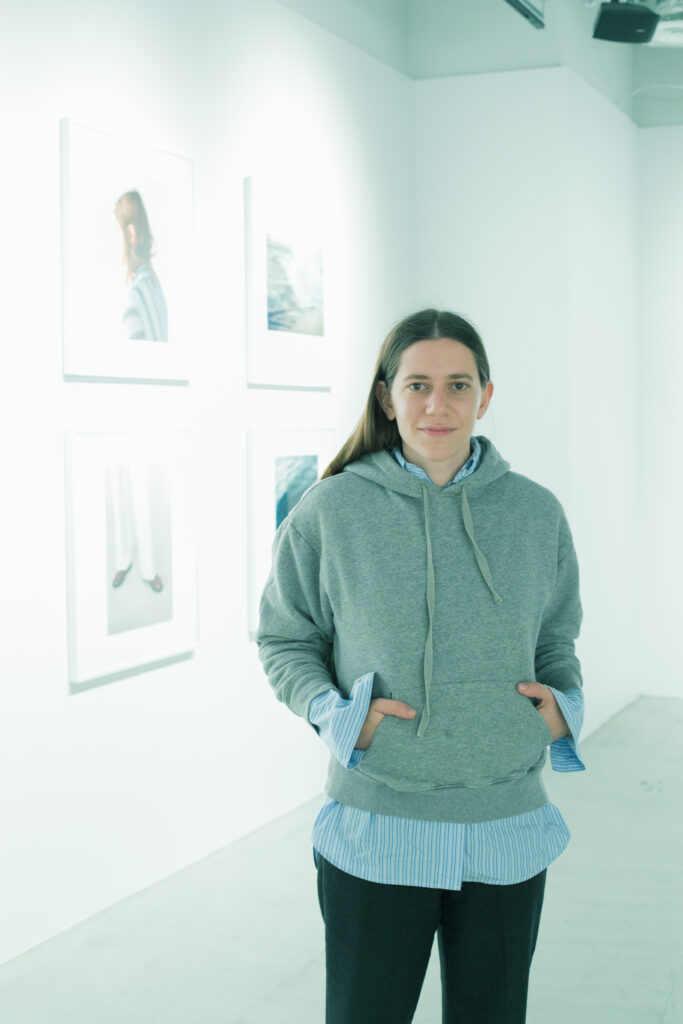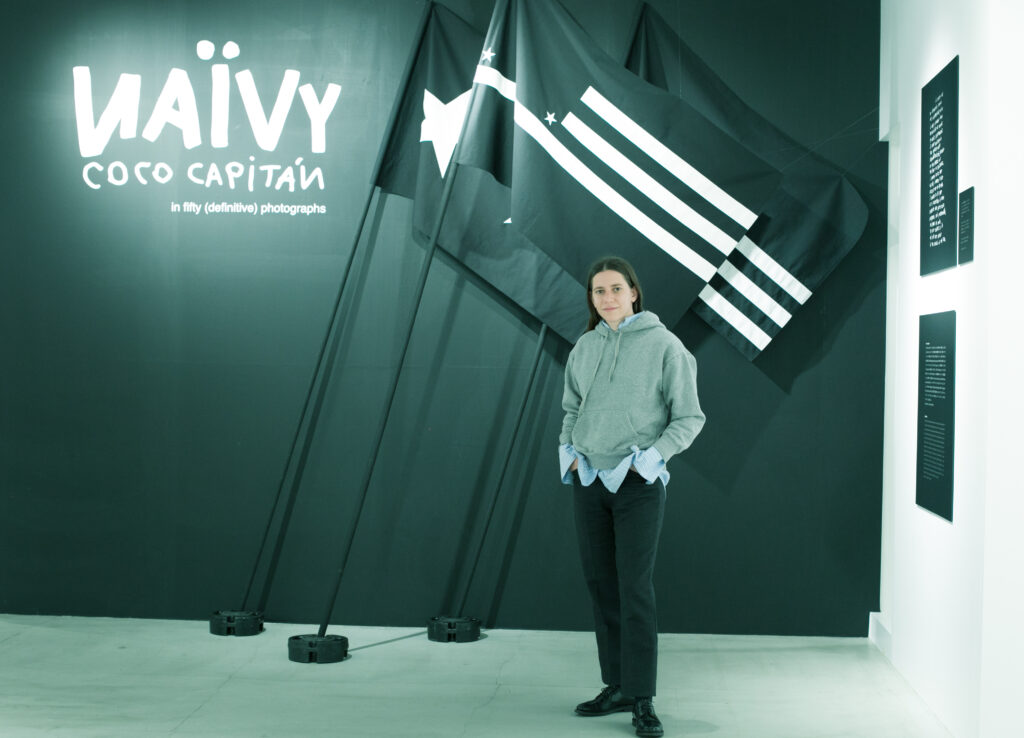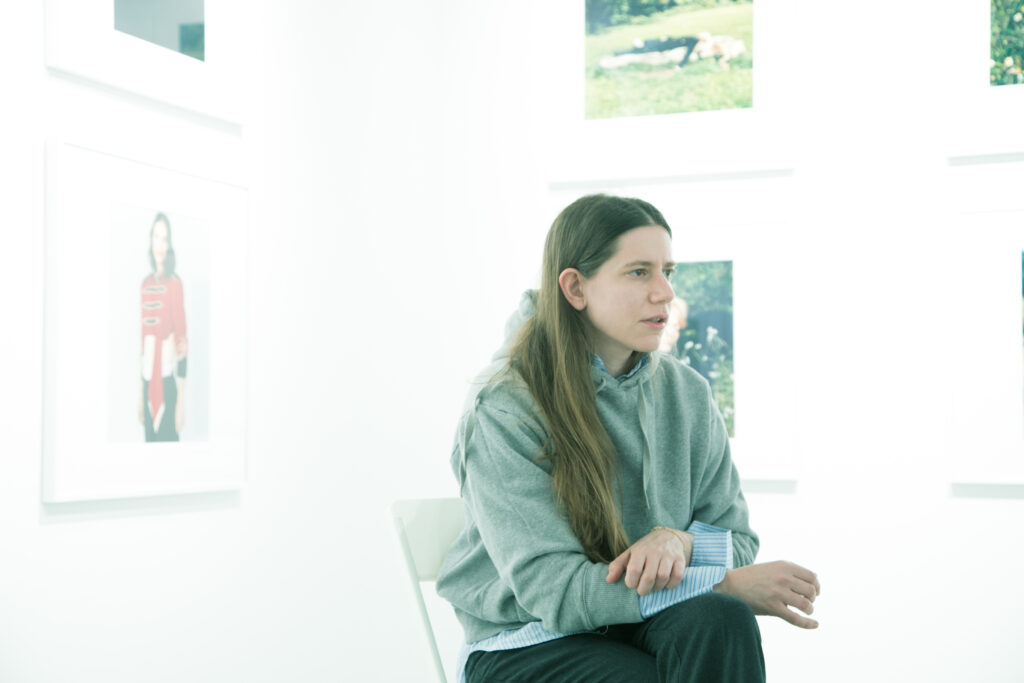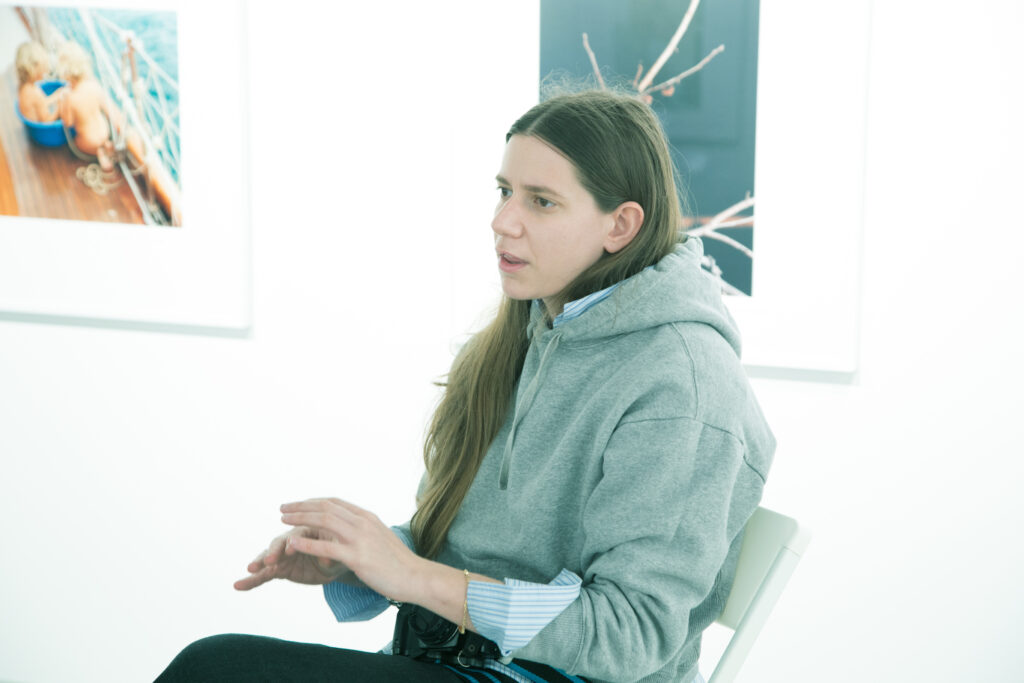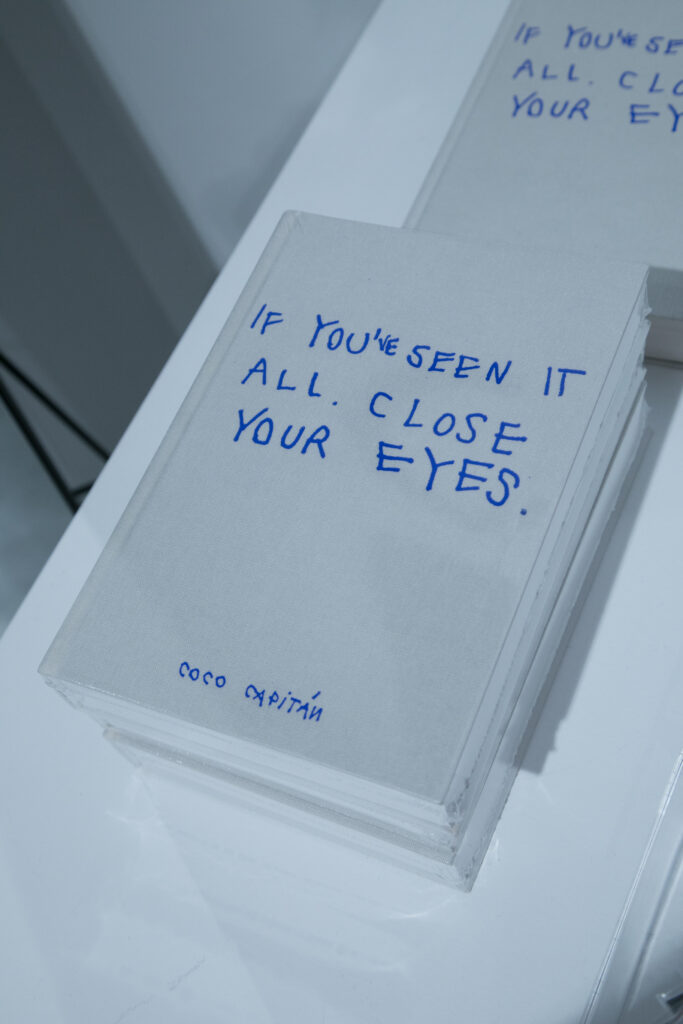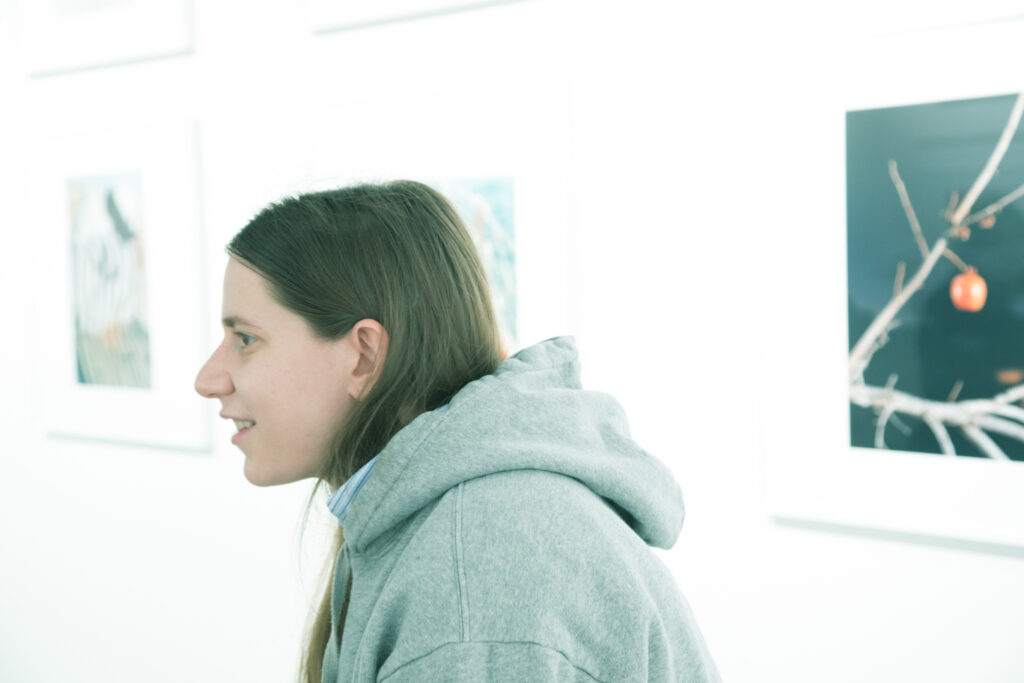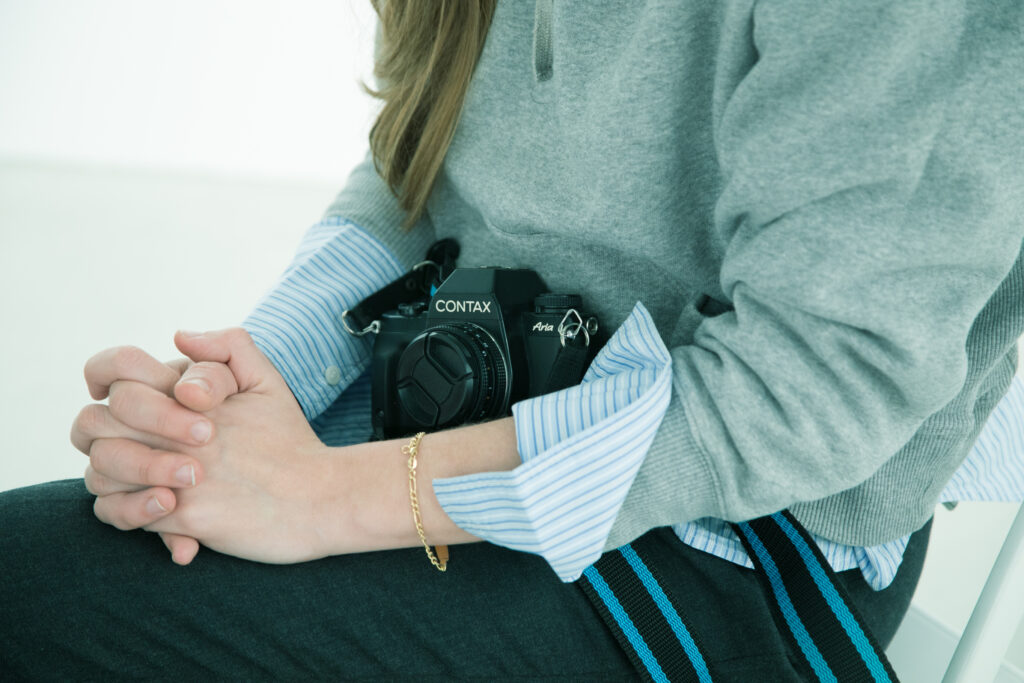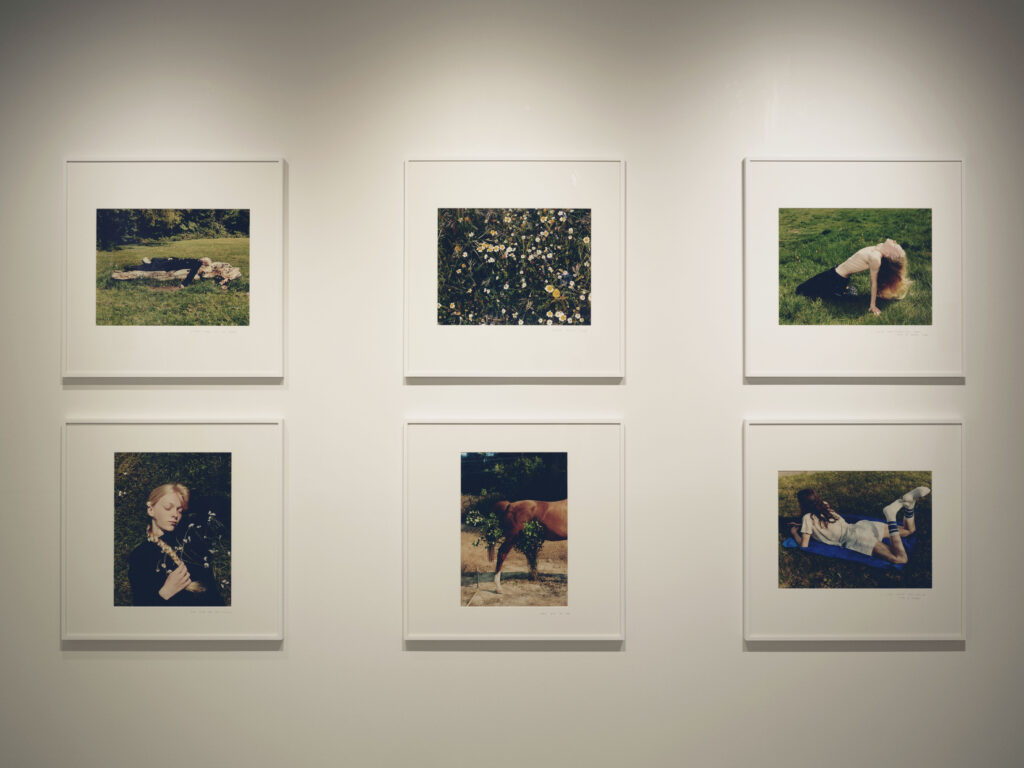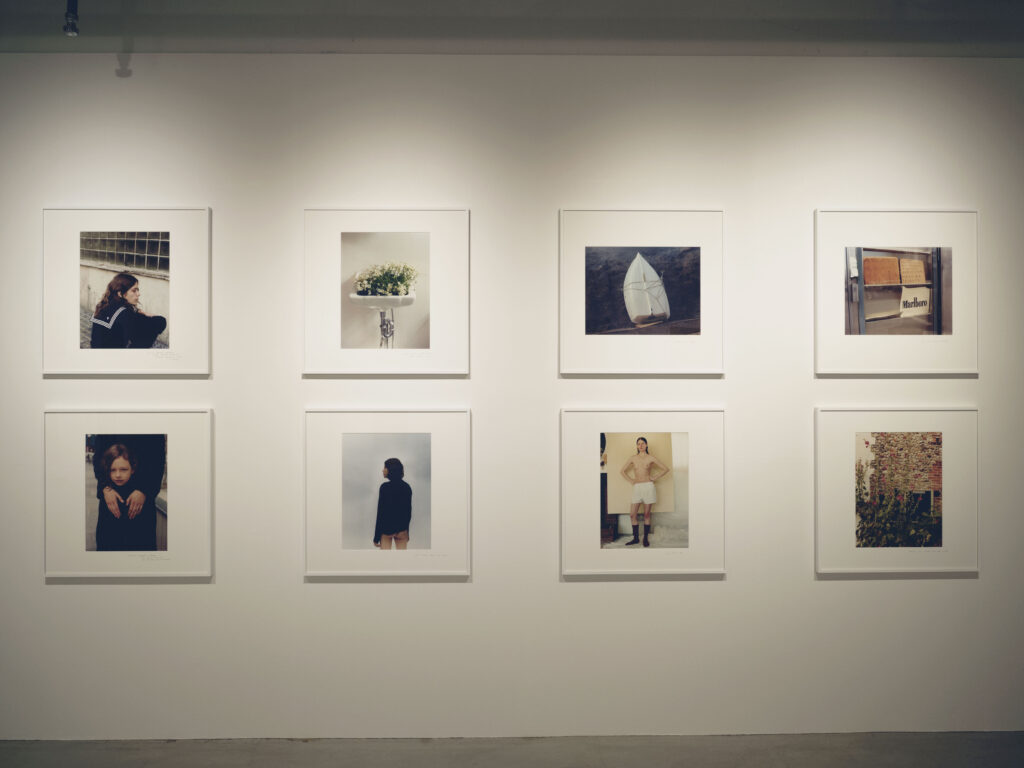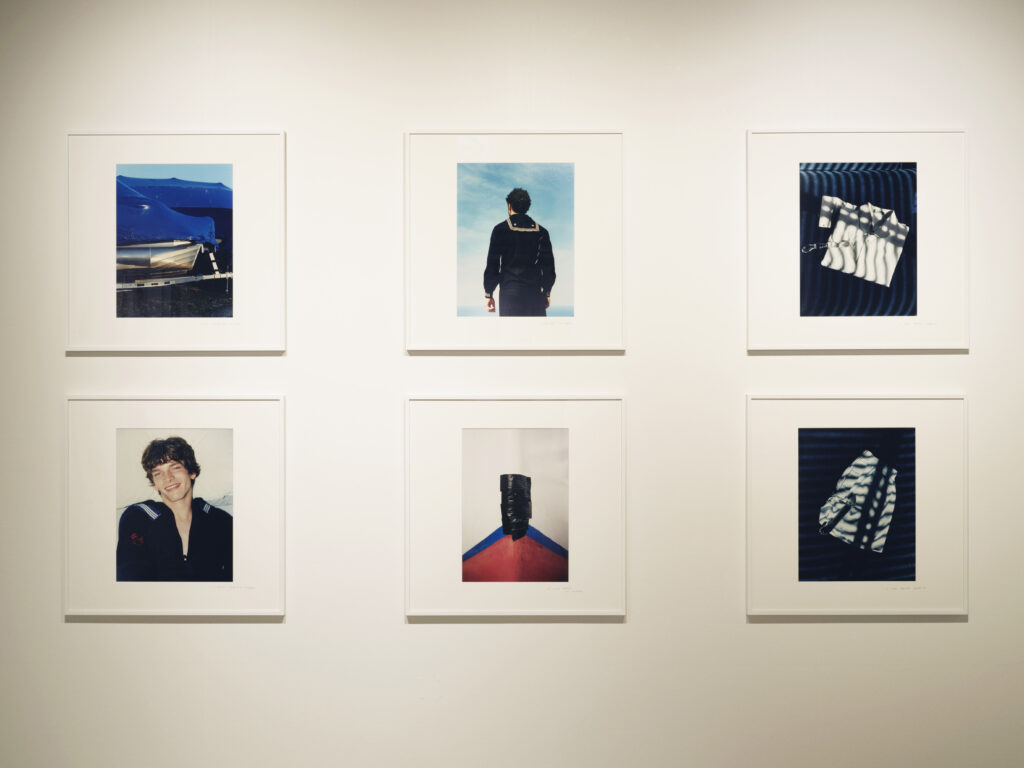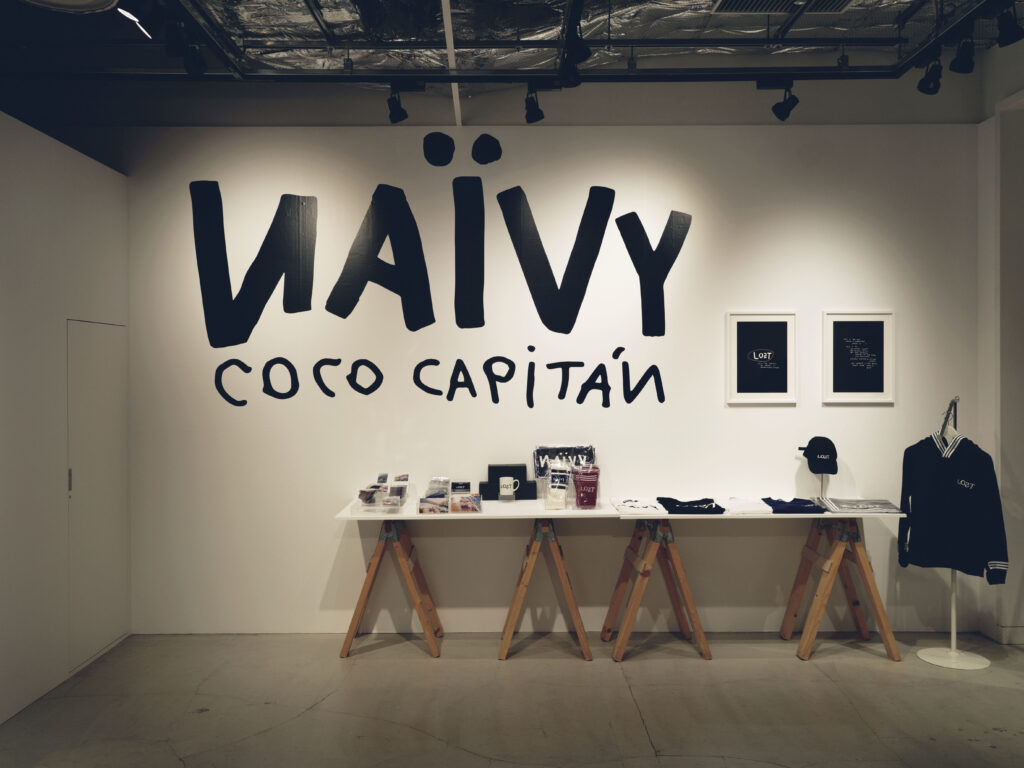Coco Capitán is a Spanish artist whose collaboration with Gucci for the Fall/Winter 2017-18 collection with her handwritten messages left striking impression on us. While studying at the Royal College of Art in London, Coco Capitán began a photography internship to earn a living and soon after she broke through as a star who would even work on campaigns for brands all over the world. In addition to her photography, her writing (#cococapitanwriting) has come into the spotlight now. Her simple, straightforward handwritings are like child’s doodles, yet the implications of them are even philosophical.
This is her first solo exhibition in Japan. At the entrance of PARCO MUSEUM TOKYO in Shibuya, we were greeted by three large flags. The two-dimensional objects, which she had presented only as a form of sketche, have three-dimensional substances here, fluttering in the non-blowing wind.
“I figured if I was going to exhibit in Japan, it would be in photography.”
— I heard that NAÏVY is a series of work that you have been photographing for 10 years. This exhibition is titled “(definitive) photographs.” Is this the culmination or final chapter of your work?
Coco Capitán (Capitán): Yes, that’s right. But rather than taking photos over a period of 10 years under a specific theme, it was an attempt to find a connection between my inner feelings and the personal photos I have taken over the past 10 years. I think that these 50 photos summarize my feelings in a better way.
— NAÏVY traveled to London (2020) and Amsterdam (2021), and this is your first solo exhibition in Japan. What are the common threads that run through the three exhibitions? And did you get any new perspectives?
Capitán: I have been working on the same concept, so they have the same title, but all the prints I am showing in Tokyo are ones I prepared specifically for this exhibition. I have always wanted to show my work in Japan.
There are a lot Japanese artists whom I admire, and I am also interested in the history of Japan. I also feel that there is a large audience in Japan that has a sensibility to photography. So I wanted to have a solo exhibition in Japan that focuses on the format of photography.
— More specifically, which Japanese artists do you like?
Capitán: My favorite Japanese photographer is Shomei Toumatsu. I am attracted to his series of photographs of Okinawa. Specifically, one of my favorite is his book Chewing Gum and Chocolate. I also like Daido Moriyama very much. I am also interested in traditional Ukiyoe prints. I like the man who painted the Big Wave. I can’t recall his name right now though.
— He is Hokusai Katsushika.
Capitán: Yeah, Hokusai. Shomei, Daido and Hokusai. They are my three favorites.
— You once described yourself as a “New traditionalist photographer” on your Twitter profile page (she also posted a screenshot of it on Instagram on January 14, 2013). How do you engage with tradition of photography and art?
Capitán: I am interested in learning more about traditional forms. With any kind of art, I think it is very important to learn the technical basis to be able to become more creative. I call myself a “new traditionalist” because the methods I practice are very traditional. I still use a film camera, and I had to learn the old-school way of doing things, from choosing and using lenses to developing the film. I believe that only when you master the basics of the technique, you have a lot of freedom and can play with newer elements to create something fresher.
— Why did you choose to study at the Royal College of Art in London?
Capitán: I grew up in a small town in the south of Spain called Seville and moved to London when I was 18. I have loved art and culture since I was a child, and I always dreamed of living in a big city where I could meet people with similar interests. The choices were New York or London. I chose London because it is close to Spain and international enough.
— How did you start your career as a photographer?
Capitán: Although I have loved photography since I was a child, I never thought of pursuing my career in it. When I moved to London, I wanted to be an artist. But I still had a vague idea of what kind of artist I wanted to be. So I went to art school (Royal College of Art) and majored in photography in addition to fine art.
Since I was financially independent at the age of 18, I started working as a photographer as an internship while attending school. It was a practical choice to earn money, but I really enjoyed the work. And then the jobs started coming in. My career as a photographer started just by accident. My focus has always been on fine art, and my introduction to photography was much more casual.
“I find it a bit boring to focus only on one thing.”
— In addition to photography, you use a variety of media, including writing, painting, and installation. Do these media complement each other, or do they work together in a collaborative way?
Capitán: I just really like to try new things. I find it a bit boring to focus only on one thing. Some people think it’s better to stick to one theme, but I am not very much interested in obtaining excellent techniques or becoming authority through it. For me, art is a process of trying out many different media and facing my limitations within them. In doing so, I want to convey a message through various media. I want to continue to jump from painting to photography then to writing and see how they interconnect with each other. That is why I like exhibitions that allow many forms to coexist in one space. I choose them in a casual way to allow them to fill up each other’s presence and concept.
— Your writing work is characterized by a mix of capital letters and mirrored letters. They are written in an nostalgic and endearing style. Is this a style that has remained unchanged since you were a child, or did you discover it in the process of pursuing art?
Capitán: I have always carried a notebook with me since I was a child. Since I was very shy, it was difficult for me to express my thoughts in words, so I would write down my thoughts and feelings and then practice putting them into words. I also drew pictures, but these were just typical of what children would draw.
I think my interest in photography also began around that time. I collected clippings from magazines and books, categorized them in a way that was easy for me to understand, and pasted them in my notebook. I would give each one a title and add a caption that explains why I liked it. There were many such notebooks. It was just like my own personal Google database.
— It seems that it is the origin of the mixed media artwork of photography and writing.
Capitán: I never thought that my writing would become a form of art. Like photography, writing started unexpectedly. When I was a student, I began to think seriously about my own artwork, and I started writing as a way to better understand how I felt about my art. When I showed them to my friends, many of them showed more interest in my writings than in my artworks. Then I started sharing my writings online (#cococapitanwriting). My collaboration with Gucci (Fall-Winter 2017-18) started out very casually. I originally worked for Gucci as a photographer, and one day Alessandro Michele saw my notebook and liked it. He asked me if I would be interested in doing their campaign with my writing instead of with my photos.
— The campaign for Gucci made you well known, and your Instagram currently has over 200,000 followers. The established style of 2 photo posts + 1 writing post is a composition that can be enjoyed as a work of art.
Capitán: For me, it used to be a more personal or casual platform that has research aspect, but it has grown very large with a larger number of followers. Now it’s more business oriented, where you can see some of the finished work and the process.
It’s a little too serious or not natural for me, and I sometimes find it boring. I wish there was a more playful platform, but Instagram is an interesting format where I can link writing, painting, and photography, so I will continue to use it.
— You mentioned that you do your research on Instagram, but how do you deal with or play with the Internet? Looking at your work, all of your photographs are hand-printed, and you often take an organic approach, such as embroidery on objects.
Capitán: Being able to connect with people is one of the advantages of the Internet, especially for me, growing up in a small town, it was a very useful tool at first. However, social media is designed to be addictive, so we tend to be constrained by it. I think that can be the ruin of creativity. So I try not to get too carried away by it. When I get home, I close the Instagram app. When I post a few times a week, I don’t reload to follow the feeds. When I’m in the studio, I put my phone in a drawer and focus on reading or spending time with others.
For example, many people fill their time waiting for the bus with digital stuff because they think it’s boring, but I don’t think it’s really boring. Ideas come from turning something over in your mind. It is important to be able to see what is happening around you.
— It reminds me of the fact that a lot of your photos are taken from the observer’s point of view.
Capitán: You can stare at the people around you on subways in London and no one will notice because people are all absorbed in their smartphones. I think I could do a series of photos of people who don’t notice when they are being photographed, if I wanted to.
“Personal and commercial coexist separately.”
— Let’s just talk about NAÏVY again. What are you trying to capture in your photographs? Please share any thoughts you have. I know the subjects are people who are close to you. The back views of them and the close-ups of the parts of their body are impressive.
Capitán: It’s improvisation. Of course I sometimes try to create an environment that facilitates good photos, but basically I don’t prepare. The subjects are close friends and partners, and I think the images capture their personalities well. The more they are distracted by something else than the camera I have, the more the essence of their personality comes out. I like to capture those moments. I tend to shoot a lot of back shots, probably because I like to observe people. It may also be related to the fact that I am very particular about details. If a person is facing forward, there is so much information in it that I tend to lose sight of the smallest details. NAÏVY is a very personal work. When it comes to commercial work, I need to be more specific, so I sometimes make sketches to prepare for it in advance.
— Is there any difference in technique between personal work and commercial photography?
Capitán: Would you like to hear about the cameras I use? My camera collection mostly consists of ones made in Japan. Almost all of my commercial work is done with the Contax 645. The reason is that I can take a lot of pictures quickly. It is a medium format camera that can take 16 negatives, has autofocus and a fast shutter speed. To be ready to shoot at any time, I have my assistants compete with each other to be the one who can load a new film the most quickly. However, because it is heavy, it is not suitable for personal use. For personal shoots, I want to have a more romantic relationship with the camera. I recently bought a Contax Aria, which is lightweight and easy to carry around. I love the flexibility of 35mm films. I usually prefer medium format and I like the beautiful lens of “FUJIFILM GF670”. Before that, I used to use LEICA R6.
— you seem to enjoy both commercial and personal photography.
Capitán: What is the best for me is a combination of both. I like to balance both at the same time, each in a completely different way.
— Are there any places you would like to visit during your stay in Tokyo?
Capitán: I have a lot of places listed in my notebook. I’m trying to organize them because I’ve been so busy before and after my visit to Japan. What I would like to see is the normal life of people. I would like to see not only the city, but also the suburban areas, and see the daily life of people living there.
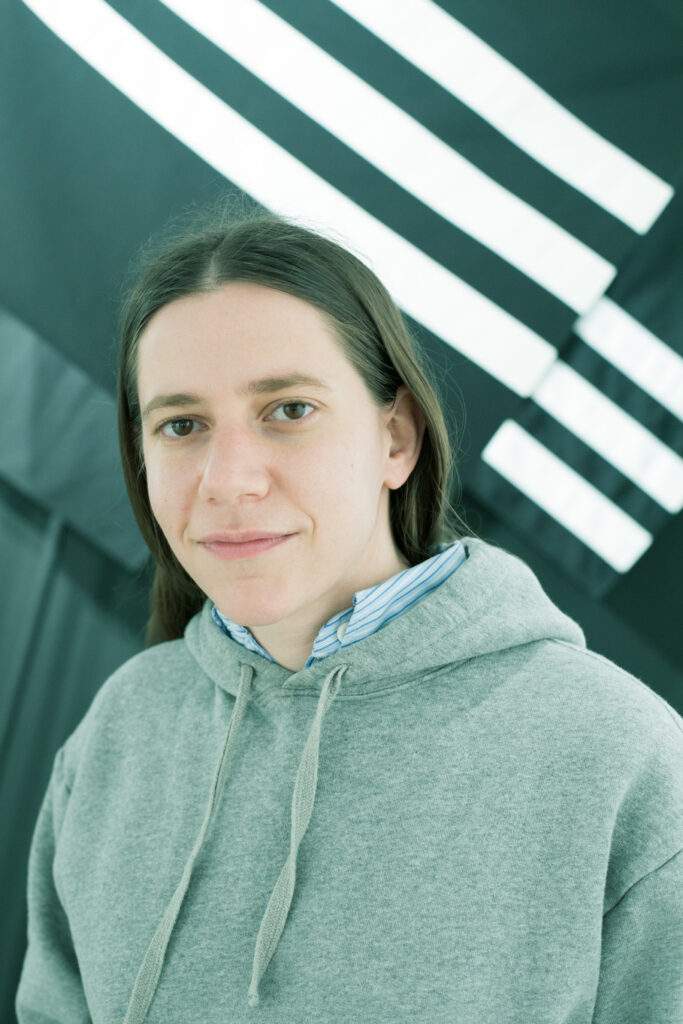
Coco Capitán
Coco Capitán was born in Seville, Spain in 1992. She completed her MA in Photography with distinction at the Royal College of Art in London in 2016. Her artistic practice spans the worlds of fine art and commercial art, which includes photography, painting, installation, and writing. Recent solo exhibitions include Naïvy (Maximilian William Gallery, London, 2021), Busy Living (European Museum of Photography, Paris, 2020), Is It Tomorrow Yet? (Daelim Museum, Seoul, 2019), and the group exhibition Infinite Identities (Musee de la Photographie de Haïs Marseille, Amsterdam, 2020). Her photography books include Naïvy, If You’ve Seen It All CloseYour Eyes, and Middle Point Between My House and China.
https://cococapitan.co.uk
Instagram:@cococapitan
Photography Mayumi Hosokura
Translation Shinichiro Sato
■Coco Capitán Exhibition NAÏVY: in fifty (definitive) photographs
The long-awaited first solo exhibition in Japan follows in the footsteps of Naïvy, her solo exhibition that opened in London during pandemic in 2020 and travelled to Amsterdam last year. The exhibition focuses on her constantly evolving artistic practice as a photographer, and showcases 50 photographs, the complete version of the recently completed Naïvy series, along with various found objects created by Capitán herself, for the first time in Japan.
Dates: April 15 – May 9
Venue: PARCO MUSEUM TOKYO
Address: Shibuya Parco 4F, 15-1 Udagawacho, Shibuya-ku, Tokyo
Time: 11:00 – 20:00
*Close at 18:00 on the last day
*Entrance until 30 minutes before closing
Admission: ¥800
https://art.parco.jp/museumtokyo/detail/?id=938

